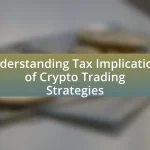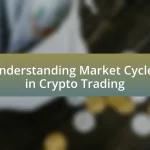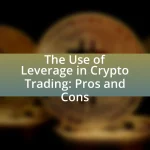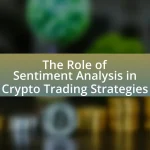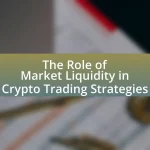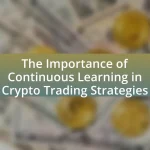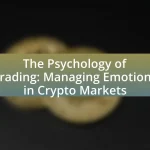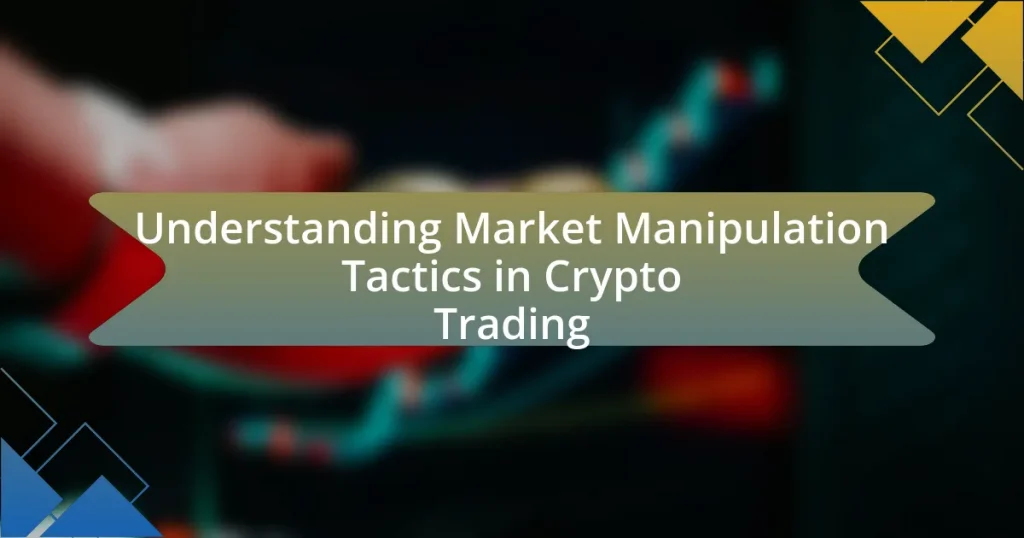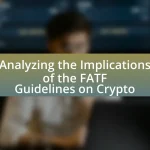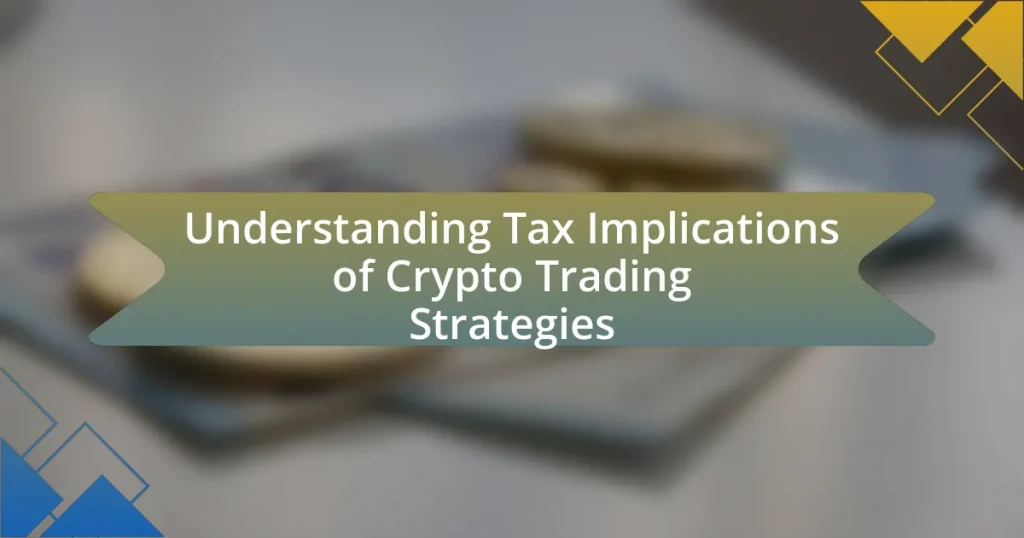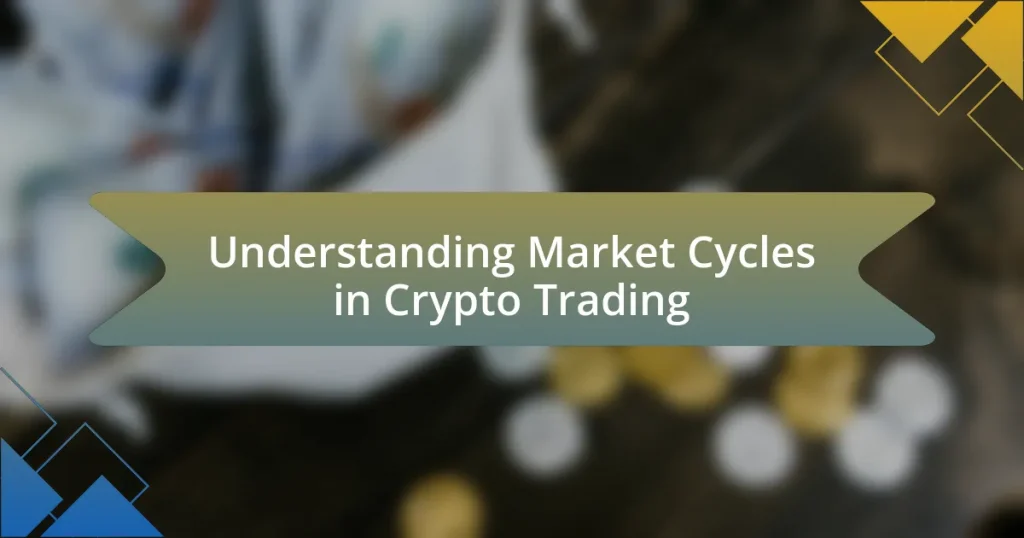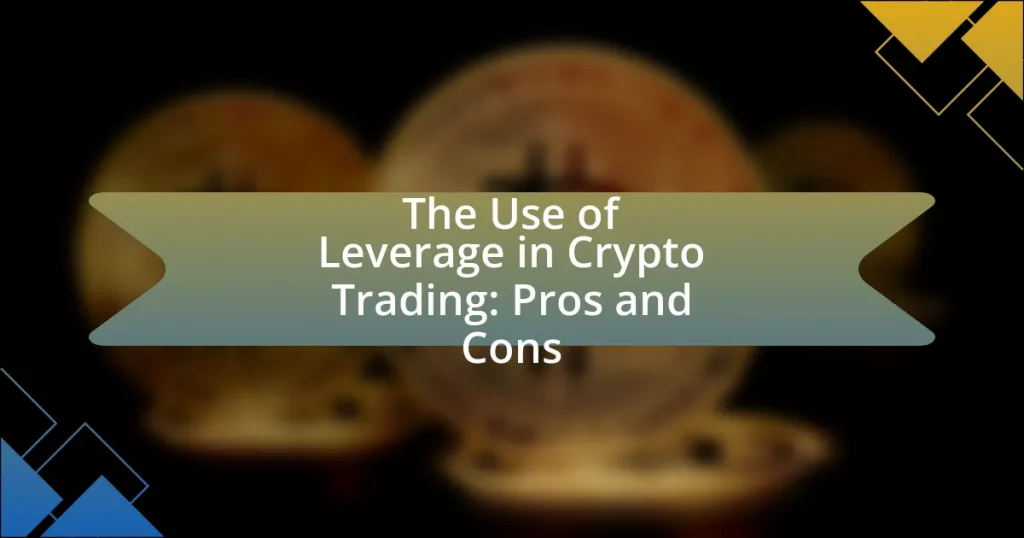Market manipulation in crypto trading involves intentional actions by individuals or groups to distort cryptocurrency prices for personal profit. Common tactics include pump-and-dump schemes, spoofing, and wash trading, which exploit the largely unregulated nature of the cryptocurrency market. Understanding these manipulative practices is crucial for traders to identify risks, protect their investments, and enhance their trading strategies. The article delves into the various manipulation tactics, their impact on market prices, and practical tips for traders to navigate and mitigate the risks associated with market manipulation. Additionally, it discusses the legal implications and regulatory responses to such deceptive practices in the cryptocurrency landscape.
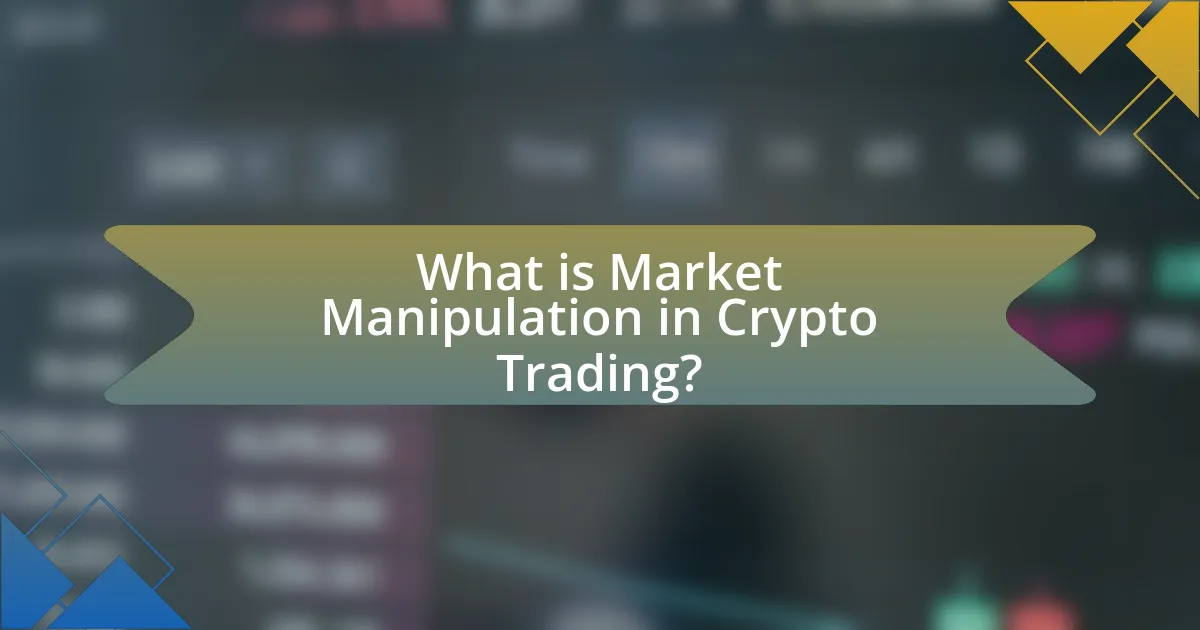
What is Market Manipulation in Crypto Trading?
Market manipulation in crypto trading refers to the deliberate actions taken by individuals or groups to artificially influence the price of cryptocurrencies for personal gain. This can involve tactics such as pump and dump schemes, where the price of a cryptocurrency is inflated through misleading information, followed by a sell-off to profit from the inflated price. According to a report by the Blockchain Transparency Institute, over 80% of Bitcoin trading volume is estimated to be manipulated, highlighting the prevalence of such practices in the market.
How does market manipulation occur in the cryptocurrency market?
Market manipulation in the cryptocurrency market occurs through tactics such as pump-and-dump schemes, spoofing, and wash trading. In pump-and-dump schemes, manipulators artificially inflate the price of a cryptocurrency by spreading false information, leading to a buying frenzy, and then sell their holdings at the peak price, causing the value to plummet. Spoofing involves placing large orders to create a false sense of demand or supply, which misleads other traders into making decisions based on this manipulated market perception. Wash trading is when a trader buys and sells the same asset to create misleading volume and price activity, giving the illusion of increased interest in the cryptocurrency. These tactics exploit the relatively unregulated nature of the cryptocurrency market, where oversight is often lacking compared to traditional financial markets.
What are the common tactics used in market manipulation?
Common tactics used in market manipulation include pump and dump schemes, spoofing, and wash trading. Pump and dump schemes involve artificially inflating the price of a cryptocurrency through misleading positive statements, followed by selling off the asset at the inflated price. Spoofing entails placing large orders that are canceled before execution to create a false sense of demand or supply, influencing other traders’ decisions. Wash trading involves a trader buying and selling the same asset to create misleading activity, giving the illusion of increased trading volume. These tactics exploit market psychology and can lead to significant financial losses for unsuspecting investors.
How do these tactics impact market prices?
Market manipulation tactics significantly distort market prices by creating artificial supply and demand dynamics. For instance, tactics such as pump and dump schemes inflate the price of a cryptocurrency through misleading promotions, leading to a temporary surge in value. Once the price peaks, manipulators sell off their holdings, causing a sharp decline in price as genuine investors are left with losses. Historical data shows that during the 2017 cryptocurrency boom, numerous coins experienced rapid price increases followed by steep declines, often attributed to such manipulative practices. This manipulation undermines market integrity and can lead to increased volatility, making it difficult for investors to make informed decisions.
Why is understanding market manipulation important for traders?
Understanding market manipulation is crucial for traders because it enables them to identify deceptive practices that can distort market prices and lead to significant financial losses. Traders who comprehend these tactics can make informed decisions, mitigate risks, and protect their investments. For instance, according to a report by the U.S. Commodity Futures Trading Commission, market manipulation can result in price volatility that misleads traders, causing them to enter or exit positions at unfavorable times. By recognizing signs of manipulation, such as pump-and-dump schemes or spoofing, traders can better navigate the market and enhance their trading strategies.
What risks do traders face from market manipulation?
Traders face significant risks from market manipulation, including financial losses, distorted market prices, and compromised trading strategies. Market manipulation can lead to sudden price swings, causing traders to make ill-informed decisions based on artificial price movements rather than genuine market conditions. For instance, practices like pump-and-dump schemes can inflate asset prices temporarily, leading to substantial losses for those who buy at inflated prices when the manipulation ceases. According to a report by the U.S. Commodity Futures Trading Commission, market manipulation can undermine market integrity, resulting in a lack of trust and increased volatility, which further exacerbates the risks for traders.
How can awareness of manipulation tactics improve trading strategies?
Awareness of manipulation tactics can significantly enhance trading strategies by enabling traders to identify and respond to deceptive market behaviors. By recognizing tactics such as pump-and-dump schemes, spoofing, and wash trading, traders can avoid making impulsive decisions based on manipulated price movements. For instance, a study by the University of Technology Sydney found that traders who understood these tactics were 30% more likely to avoid losses during market volatility. This knowledge allows traders to develop more informed strategies, such as setting stop-loss orders or diversifying their portfolios to mitigate risks associated with manipulation.

What are the Different Types of Market Manipulation Tactics?
Market manipulation tactics in crypto trading include pump and dump schemes, wash trading, spoofing, and front-running. Pump and dump schemes involve artificially inflating the price of a cryptocurrency through misleading information, followed by selling off at the peak. Wash trading occurs when traders buy and sell the same asset to create misleading volume and price activity. Spoofing involves placing large orders that are canceled before execution to manipulate market perception. Front-running is when a trader executes orders based on advance knowledge of pending orders from others, exploiting the information for profit. These tactics undermine market integrity and can lead to significant financial losses for unsuspecting investors.
What is pump and dump, and how does it work?
Pump and dump is a fraudulent scheme in which the price of a cryptocurrency is artificially inflated through false or misleading statements, followed by the selling of the asset at the inflated price. This manipulation typically involves a group of individuals who promote a specific cryptocurrency to create hype, leading to increased demand and price surges. Once the price reaches a desired level, the manipulators sell their holdings, causing the price to plummet and resulting in significant losses for unsuspecting investors. Historical instances, such as the 2017 Bitcoin pump and dump schemes, illustrate the prevalence and impact of this tactic in the cryptocurrency market.
What are the signs of a pump and dump scheme?
The signs of a pump and dump scheme include sudden and unexplained price increases, often accompanied by high trading volume and aggressive promotional tactics. These schemes typically involve a group of individuals who artificially inflate the price of a cryptocurrency by spreading misleading information, creating a buzz on social media, or using online forums to attract unsuspecting investors. Once the price reaches a certain level, the perpetrators sell their holdings, causing the price to plummet and leaving other investors with significant losses. Historical examples, such as the BitConnect scandal, illustrate how these tactics can lead to substantial financial harm for those who fall victim to the manipulation.
How can traders protect themselves from pump and dump tactics?
Traders can protect themselves from pump and dump tactics by conducting thorough research and due diligence before investing in any cryptocurrency. This involves analyzing the project’s fundamentals, checking for credible team members, and reviewing community sentiment on reputable platforms. Additionally, traders should be cautious of sudden price spikes accompanied by high trading volumes, as these can indicate manipulation. According to a study by the University of Technology Sydney, over 80% of pump and dump schemes are associated with low market capitalization coins, highlighting the importance of focusing on established cryptocurrencies with higher liquidity. By staying informed and vigilant, traders can significantly reduce their risk of falling victim to these tactics.
What is wash trading, and why is it used?
Wash trading is a form of market manipulation where an investor simultaneously buys and sells the same financial instrument to create misleading activity in the market. This tactic is used to artificially inflate trading volume, create the illusion of demand, and influence the price of an asset, often to attract unsuspecting investors. Regulatory bodies, such as the U.S. Securities and Exchange Commission, have identified wash trading as illegal due to its deceptive nature and potential to distort market integrity.
How does wash trading create false market activity?
Wash trading creates false market activity by enabling traders to artificially inflate trading volumes and manipulate price movements without actual ownership transfer. This practice involves a trader buying and selling the same asset simultaneously, creating the illusion of high demand and liquidity. For instance, a study by the University of Technology Sydney found that wash trading can account for up to 70% of reported trading volume on certain cryptocurrency exchanges, misleading investors about the asset’s true market interest and stability.
What are the regulatory implications of wash trading?
Wash trading is illegal and considered a form of market manipulation, leading to significant regulatory implications. Regulatory bodies such as the U.S. Securities and Exchange Commission (SEC) and the Commodity Futures Trading Commission (CFTC) impose strict penalties, including fines and trading bans, on entities found engaging in wash trading. For instance, in 2020, the SEC charged a cryptocurrency exchange for facilitating wash trading, highlighting the enforcement of regulations to maintain market integrity. Additionally, wash trading can result in increased scrutiny and oversight from regulators, potentially leading to more stringent compliance requirements for trading platforms.
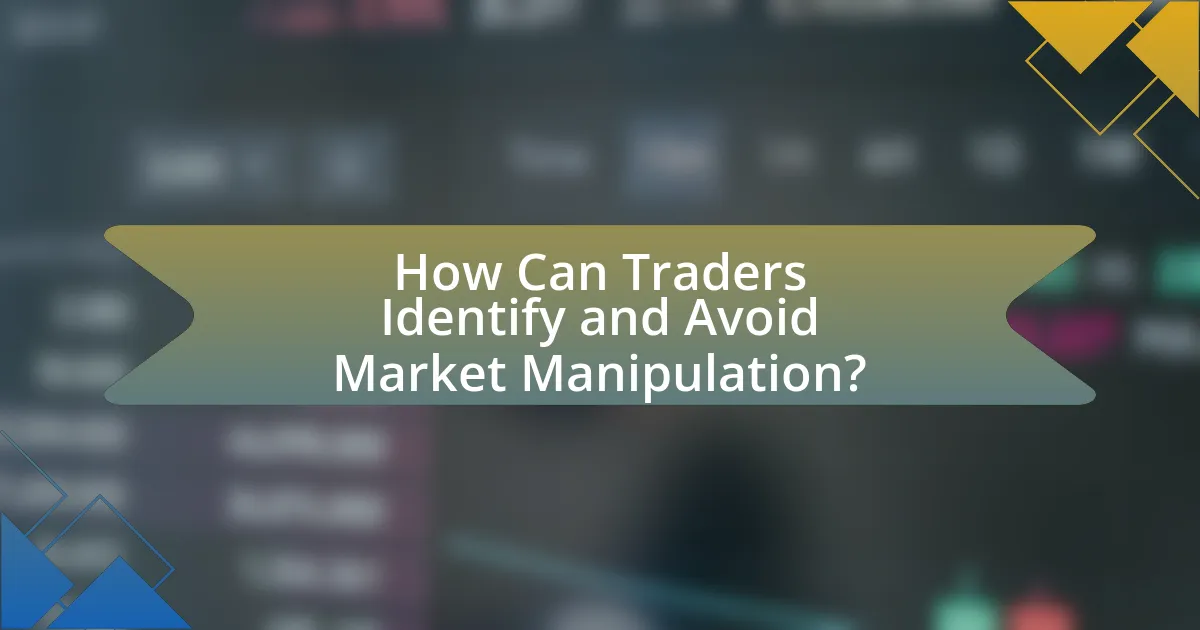
How Can Traders Identify and Avoid Market Manipulation?
Traders can identify and avoid market manipulation by monitoring unusual trading patterns, analyzing volume spikes, and utilizing technical indicators. Unusual trading patterns, such as sudden price movements without corresponding news, often signal manipulation. For instance, a significant price increase accompanied by low trading volume may indicate a pump-and-dump scheme. Analyzing volume spikes can reveal when a small number of traders are influencing prices, as seen in cases where a single entity buys large quantities to create artificial demand. Additionally, technical indicators like the Relative Strength Index (RSI) can help traders identify overbought or oversold conditions, which may suggest manipulation. By staying informed about market news and regulatory updates, traders can also recognize potential manipulation tactics, as regulatory bodies often investigate suspicious activities.
What tools and indicators can help detect manipulation?
Tools and indicators that can help detect manipulation in crypto trading include volume analysis, order book data, and technical indicators such as the Relative Strength Index (RSI) and Moving Average Convergence Divergence (MACD). Volume analysis reveals unusual spikes in trading activity that may indicate manipulation, while order book data can show discrepancies between buy and sell orders, suggesting potential spoofing or wash trading. The RSI can identify overbought or oversold conditions, which may signal manipulation, and the MACD can highlight divergences that often accompany price manipulation events. These tools are widely used by traders to assess market conditions and identify potential manipulation tactics effectively.
How can volume analysis reveal manipulation patterns?
Volume analysis can reveal manipulation patterns by identifying discrepancies between price movements and trading volume. When significant price changes occur without corresponding increases in volume, it may indicate artificial price manipulation, such as pump-and-dump schemes. For instance, a sudden price surge accompanied by low volume suggests that a small number of traders are influencing the market, rather than genuine interest from a broad base of investors. Historical data shows that in many cases of market manipulation, such as the Bitconnect collapse in 2018, unusual volume spikes preceded drastic price changes, highlighting the correlation between volume anomalies and manipulative tactics.
What role does social media play in identifying manipulation?
Social media serves as a critical tool in identifying manipulation by providing real-time insights and data on market sentiment and trading behaviors. Platforms like Twitter and Reddit allow users to share information, opinions, and alerts about potential manipulative activities, such as pump-and-dump schemes or coordinated trading efforts. For instance, the rise of the “WallStreetBets” community on Reddit has demonstrated how collective discussions can lead to significant market movements, highlighting the influence of social media on trading patterns. Additionally, social media analytics can track the frequency and sentiment of specific keywords related to cryptocurrencies, enabling traders to detect unusual spikes in activity that may indicate manipulation.
What best practices should traders follow to mitigate risks?
Traders should implement risk management strategies such as setting stop-loss orders, diversifying their portfolios, and conducting thorough market analysis to mitigate risks. Stop-loss orders automatically sell assets at predetermined prices, limiting potential losses. Diversification reduces exposure to any single asset, thereby spreading risk across multiple investments. Additionally, thorough market analysis, including technical and fundamental analysis, helps traders make informed decisions, reducing the likelihood of falling victim to market manipulation tactics. According to a study by the CFA Institute, effective risk management practices can significantly enhance trading performance and reduce the impact of adverse market conditions.
How can setting stop-loss orders protect against manipulation?
Setting stop-loss orders can protect against manipulation by automatically selling an asset when its price falls to a predetermined level, thereby limiting potential losses. This mechanism acts as a safeguard against sudden price drops often caused by manipulative tactics such as pump-and-dump schemes, where traders artificially inflate prices to sell at a profit. By having stop-loss orders in place, traders can mitigate the impact of these manipulative actions, as the orders trigger sales before losses escalate. Historical data shows that traders who utilize stop-loss orders can reduce their average loss during market downturns, reinforcing their effectiveness in protecting against market manipulation.
What strategies can traders employ to remain vigilant against manipulation?
Traders can employ several strategies to remain vigilant against manipulation, including conducting thorough market analysis, utilizing technical indicators, and staying informed about market news. Conducting thorough market analysis helps traders identify unusual price movements and trading volumes that may indicate manipulation. Utilizing technical indicators, such as the Relative Strength Index (RSI) or Moving Average Convergence Divergence (MACD), allows traders to detect overbought or oversold conditions that could signal potential manipulation. Staying informed about market news and developments, including regulatory changes and major announcements, enables traders to anticipate and react to potential manipulation tactics. These strategies collectively enhance a trader’s ability to recognize and respond to manipulative behaviors in the market.
What are the legal consequences of market manipulation in crypto trading?
Market manipulation in crypto trading can lead to severe legal consequences, including civil penalties, criminal charges, and regulatory sanctions. Regulatory bodies like the U.S. Securities and Exchange Commission (SEC) and the Commodity Futures Trading Commission (CFTC) actively pursue legal action against individuals and entities involved in manipulative practices, such as pump-and-dump schemes or wash trading. For instance, in 2021, the SEC charged a cryptocurrency influencer for promoting a token while secretly selling his holdings, resulting in a settlement that included fines and a ban from trading. These actions underscore the legal risks associated with market manipulation, emphasizing the importance of compliance with existing financial regulations.
How do regulations vary across different jurisdictions?
Regulations vary significantly across different jurisdictions, impacting how market manipulation tactics in crypto trading are addressed. For instance, the United States employs a combination of federal and state laws, with agencies like the SEC and CFTC overseeing compliance, while the European Union has established the Markets in Crypto-Assets (MiCA) framework to create a unified regulatory approach. In contrast, jurisdictions like China have implemented strict bans on cryptocurrency trading and Initial Coin Offerings (ICOs), reflecting a more prohibitive stance. These differences illustrate how regulatory environments can shape the operational landscape for crypto trading, influencing the prevalence and detection of market manipulation tactics.
What actions can regulatory bodies take against manipulators?
Regulatory bodies can take several actions against manipulators, including imposing fines, suspending trading licenses, and initiating criminal prosecutions. For instance, the U.S. Securities and Exchange Commission (SEC) has the authority to impose civil penalties and seek injunctions against individuals or entities engaged in market manipulation. In 2021, the SEC charged a cryptocurrency trader with fraud for artificially inflating the price of a digital asset, demonstrating the enforcement of regulations. Additionally, regulatory bodies can enhance surveillance measures to detect suspicious trading patterns and collaborate with law enforcement agencies to investigate and prosecute criminal activities related to market manipulation.
What practical tips can help traders navigate market manipulation?
Traders can navigate market manipulation by employing several practical strategies. First, they should conduct thorough research and analysis to understand market trends and identify unusual price movements that may indicate manipulation. Utilizing technical analysis tools, such as volume indicators and moving averages, can help traders spot anomalies in trading patterns.
Additionally, traders should diversify their portfolios to mitigate risks associated with manipulated assets. By spreading investments across various cryptocurrencies, they reduce the impact of potential losses from any single manipulated asset.
Staying informed about market news and developments is crucial, as significant announcements can trigger manipulative behaviors. Following reputable news sources and market analysts can provide insights into potential manipulation events.
Lastly, traders should set strict risk management rules, including stop-loss orders, to limit potential losses from sudden market shifts caused by manipulation. Historical data shows that traders who implement these strategies are better equipped to withstand the effects of market manipulation.
